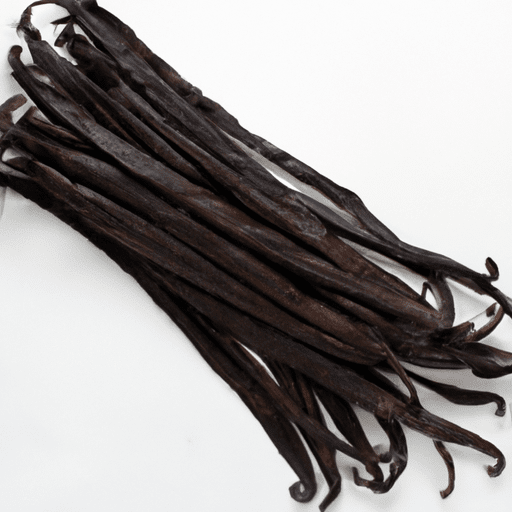Tahitian Vanilla Bean: Delicate Aroma and Exquisite Flavor
If you’re an avid baker or cooking enthusiast, chances are you have come across vanilla in your culinary adventures. While there are various types of vanilla available, one that stands out with its exceptional qualities is the Tahitian vanilla bean. This variety, native to the majestic islands of Tahiti, offers a delicate aroma and exquisite flavor that elevate any dish it graces. Join us as we dive into the captivating world of Tahitian vanilla beans, exploring their taste, common uses in cooking, nutritional value, and even a sprinkle of interesting history and facts!
Taste and Aroma: A Tropical Sensation
Tahitian vanilla beans are renowned for their unique flavor profile. Unlike their more commonly found counterpart, the Madagascar vanilla bean, Tahitian vanilla boasts a sweeter, fruity flavor with hints of cherry and prune. Its exquisite taste is often described as vibrant and sophisticated, making it a favorite among chefs and food connoisseurs alike.
One of the key distinguishing factors of Tahitian vanilla is its delicate aroma. While other vanilla varieties possess a rich, robust scent, Tahitian vanilla emanates a more subtle and floral fragrance. Close your eyes, and let the enchanting aromas transport you to the turquoise waters and lush landscapes of Tahiti.
Culinary Uses: Elevating Sweet and Savory Dishes
Tahitian vanilla beans are a versatile ingredient that can enhance both sweet and savory dishes. In baking, these beans are a baker’s secret weapon, infusing cakes, cookies, and pastries with their distinct flavor. From creamy custards to luscious ice creams, nothing can compare to the subtle complexity that Tahitian vanilla brings.
But don’t limit yourself to desserts alone! Chefs across the globe have also embraced Tahitian vanilla in savory dishes. Its delicate flavor can beautifully complement seafood, poultry, and even vegetable dishes. A touch of Tahitian vanilla in a savory sauce or marinade can add a surprising depth that will leave your taste buds tantalized and impressed.
Nutritional Benefits: A Touch of Goodness
Alongside their exquisite taste, Tahitian vanilla beans also offer a range of nutritional benefits. While they may be small in size, they are packed with several essential vitamins and minerals. Tahitian vanilla is a good source of potassium, calcium, manganese, and iron. Additionally, it contains antioxidants that can help reduce inflammation and promote overall well-being.
It’s important to note that the nutritional benefits of vanilla can be fully enjoyed when consumed in moderation. So go ahead and savor the unique flavors of Tahitian vanilla, knowing you’re adding a touch of goodness to your dishes.
History and Fun Facts: A Journey through Time
Vanilla has a rich history entwined with ancient civilizations and European exploration. While Tahitian vanilla may not have the same centuries-old legacy as some other varieties, it has its own fascinating tale.
Tahitian vanilla was introduced to the islands of Tahiti in the late 19th century by Admiral Ferdinand-Alphonse Hamelin as a gift from the French government. The lush, volcanic soil and tropical climate of Tahiti proved to be the perfect environment for these delicate orchids to thrive. Over time, Tahitian vanilla became renowned for its exceptional quality and distinct flavor, captivating the palates of chefs, gourmands, and travelers around the world.
Fun fact: Unlike other vanilla varieties that are primarily pollinated by bees, Tahitian vanilla relies on a unique method of pollination. Local farmers hand-pollinate each flower, delicately transferring the pollen from the male anther to the female stigma. This labor-intensive process ensures the production of high-quality beans but also adds to their rarity and desirability.
Conclusion
In the realm of vanilla, Tahitian vanilla beans reign supreme with their delicate aroma, exquisite flavor, and fascinating history. Whether you’re a passionate baker, an adventurous chef, or simply someone who appreciates the finer things in life, Tahitian vanilla is a must-have in your culinary repertoire. So go ahead, indulge your senses, and let the tropical sensation of Tahitian vanilla transport your taste buds to paradisiacal bliss.
Tahitian Vanilla Bean
Origin: Tahitian vanilla beans, also known as Vanilla tahitensis, are primarily grown in Tahiti and other island nations in the South Pacific, such as Papua New Guinea, Fiji, and Tonga. This particular species of vanilla orchid is a member of the Vanilla planifolia family, which is also responsible for the commonly used Bourbon vanilla.
Common Uses: Tahitian vanilla beans are highly prized for their floral and fruity aroma, as well as their delicate and sweet flavor profile. They are often used in desserts, beverages, and confections to add a unique tropical twist. Common uses include vanilla ice cream, custards, cakes, pastries, and flavored syrups.
Nutritional Benefits: In terms of nutritional benefits, Tahitian vanilla beans are low in calories and fat. While they do not provide significant amounts of vitamins or minerals, they do contain small amounts of potassium and calcium. However, it’s important to note that the primary reason for using Tahitian vanilla beans in cooking is for their flavor rather than their nutritional value.
Unique Properties: One of the most distinctive features of Tahitian vanilla beans is their distinctive flavor and aroma. Unlike other vanilla varieties, they are known for their fruity and floral notes, which often resemble cherry, licorice, and anise. Another unique property is their moist texture, which can make them slightly harder to handle compared to other drier vanilla beans.
Historical Significance: Tahitian vanilla beans have a rich historical significance in the cultures of the South Pacific. The vanilla orchid was believed to have been brought to Tahiti by French Admiral Louis-Antoine de Bougainville in the late 18th century. Since then, Tahiti has become renowned for its high-quality vanilla production, capturing the attention of chefs and culinary enthusiasts worldwide.




Use the share button below if you liked it.
It makes me smile, when I see it.